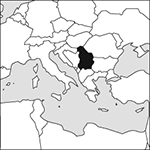
Source: MAPS IN MINUTES™ © RH Publications (1997)
Capital:
Belgrade
Area:
77,474 sq km (29,913 sq miles)
Population:
7,243,007 (2013 est)
Currency:
1 dinar = 100 paras
Religions:
Eastern Orthodox 84.6%; Roman Catholic 5.0%; Muslim 3.1%
Ethnic Groups:
Serb 83.3%; Hungarian 3.5%; Romany 2.1%; Bosniak 2.0%
Languages:
Serbian (official), Hungarian, Bosnian, Romany
International Organizations:
UN; OSCE; Euro-Atlantic Partnership Council
A republic in SE Europe.
Physical
It is mountainous in the south, descending to fertile plains in the north.
Economy
The economy was badly damaged in the 1990s by mismanagement, civil war, international isolation, and NATO bombing in 1999. Recovery since has been slow, with gradual privatization of state-owned industries and reintegration into the international community. Agriculture employs a quarter of the workforce, with the main crops being cereals, sunflowers, soyabeans, sugar beet, fruit, and vegetables. Principal industries include vehicles, metals, furniture, food processing, and machinery. Exports include cars, machinery, plastics, foodstuffs and wine, iron and steel, rubber, cereals, and clothing.
History
An independent state as early as the 6th century, Serbia was conquered by the Turks in the 14th century. With the decline of Ottoman power in the 19th century, the Serbs successfully pressed for independence, finally winning nationhood in 1878. Subsequent Serbian ambitions to found a South Slav nation state brought the country into rivalry with the Austro-Hungarian empire and eventually contributed to the outbreak of World War I. Despite early successes against the Austrians, Serbia was occupied by the Central Powers and was, after the end of hostilities, absorbed into the new state of Yugoslavia. With the secession of four out of the six republics from the collective state in 1991–92, Serbia struggled to retain the viability of Yugoslavia and found itself internationally isolated as a result of armed conflict with neighbouring Slovenia and Croatia, involvement in the civil war in Bosnia, and the suppression of Albanian nationalism in the Kosovo region. In 1992 Serbia and Montenegro formed a new Federal Republic of Yugoslavia. In late 1995 the governments of Serbia, Croatia, and Bosnia and Herzegovina accepted a US-brokered peace settlement. In 1997 Slobodan Milošević was appointed President of Yugoslavia and Milan Milutinović succeeded him as President of Serbia. In 1998 the Serbian army attempted to suppress ethnic Albanians in Kosovo, brutally destroying whole villages. After Serbia refused to accept an international peace plan in 1999, NATO began a campaign of airstrikes against Yugoslavia. The response of the Serbian army was to intensify its ‘ethnic cleansing’ of Albanians, some 1.5 million of whom were displaced. In June 1999 the Serbs surrendered in the face of intensified bombing and their army withdrew—to be replaced by an international peacekeeping force. Kosovo declared independence from Serbia in 2008. Milošević was deposed in a bloodless revolution in 2000 and Vojislav Kostunica took over. In 2002 Serbia joined with Montenegro in a looser federation, the union of Serbia and Montenegro. This was dissolved in 2006, when Montenegrins voted for complete independence in a referendum. In 2009, Serbia made a formal application to join the EU, shortly after Serbians gained visa-free travel within the Schengen area. Negotiations were stalled by the EU, however, until Serbia and Kosovo had normalized relations.
- Paasche index
- Paasche price index
- PABX
- PAC
- paca
- pacemaker
- PACF
- Pachycephalosauridae
- pachydont
- pachytene
- Pacific- and Indian-Ocean common water
- Pacific-Antarctic Ridge
- Pacific Campaigns (1941–45)
- pacific coast
- Pacific Decadal Oscillation
- Pacific Ocean
- Pacific Plate
- Pacific Province
- Pacific Ring of Fire
- Pacific scandal (1873)
- Pacific-type coast
- Pacific-type margin
- pacifism
- Pacinian corpuscle
- pack